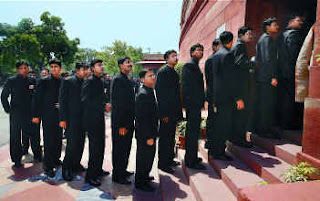A civil servant is responsible for the law and order and general administration in the area under his work. Typically the functions of an IAS officer are as follows :
Most IAS officers start their careers in the state administration at the sub-divisional level as a sub divisional magistrate. They are entrusted with the law and order situation of the city along with general administration and development work of the ares under their charge. The post of District Officer is also known as District Magistrate, District Collector or Deputy Commissioner. Since it is the most identifiable position in the IAS services, it is also considered the most prestigious. At the top of the hierarchy of IAS officers at the Center is the Cabinet Secretary followed by Secretary/Additional Secretary, Joint Secretary, Director, Deputy Secretary and Under Secretary. These posts are filled according to seniority.
The time scale of the officers of the Indian Administrative Service:
Expecting feedback and comments from my readers....
- To handle the daily affairs of the government, including framing and implementation of policy in consultation with the minister-in-charge of the concerned ministry.
- Implementation of policy requires supervision.
- Implementation requires traveling to places where the policies are being implemented.
- Implementation also includes expenditure of public funds which again requires personal supervision as the officers are answerable to the Parliament and State Legislature for any irregularities that may occur.
- In the process of policy formulation and decision making, officers at various levels like joint secretary, deputy secretary make their contributions and the final shape to the policy is given or a final decision is taken with the concurrence of the minister concerned or the cabinet depending upon the gravity the issue.
Most IAS officers start their careers in the state administration at the sub-divisional level as a sub divisional magistrate. They are entrusted with the law and order situation of the city along with general administration and development work of the ares under their charge. The post of District Officer is also known as District Magistrate, District Collector or Deputy Commissioner. Since it is the most identifiable position in the IAS services, it is also considered the most prestigious. At the top of the hierarchy of IAS officers at the Center is the Cabinet Secretary followed by Secretary/Additional Secretary, Joint Secretary, Director, Deputy Secretary and Under Secretary. These posts are filled according to seniority.
The time scale of the officers of the Indian Administrative Service:
| Position in the Government of India | Level and Rank | Order of Precedence (As per Presidential order) | |
|---|---|---|---|
| 1 | Junior Time Scale | Entry-level | -- |
| 2 | Senior Time Scale | Under Secretary to Government of India (Equivalent to) | -- |
| 3 | Junior Administrative Grade | Deputy Secretary to Government of India | -- |
| 4 | Selection Grade | Director to Government of India | -- |
| 5 | Joint Secretary | Joint Secretary to Government of India | 26 |
| 6 | Additional Secretary | Additional Secretary to Government of India | 25 |
| 7 | Secretary | Secretary to Government of India (The highest rank in a department) | 23 |
| 8 | Cabinet Secretary | Cabinet Secretary to Government of India (only one) (Ex-Officio and Chairman of the Civil Services Board of the Republic of India; the chief of the IAS and head of all civil services under the rules of business of the government of India) | 11 |
Expecting feedback and comments from my readers....














